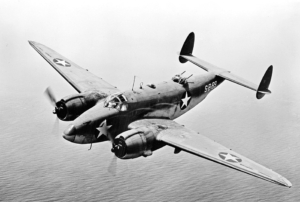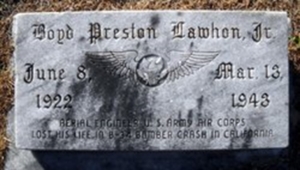Scroll of Honor – Boyd Preston Lawhon, Jr.
Icing
Written by: Kelly Durham
Boyd Preston Lawhon, Jr. wasted no time. He enlisted in the Army Air Force just six days after the Japanese attack on Pearl Harbor yanked the United States into World War II. Lawhon had attended Clemson College the previous two years to study civil engineering, but had then left school and was working as a machinist at Sonoco Products in his hometown of Hartsville. When war came, Lawhon responded.
Building on his civil engineering studies, Lawhon was sent to Keesler Field at Biloxi, Mississippi for technical training to become a flight engineer. As such, his duties were to assist the pilot and copilot of multi-engine aircraft with the inflight monitoring of powerplants and fuel supplies.
On March 13, 1943, Lawhon was detailed as part of the crew to ferry a Lockheed Ventura RB-34 reconnaissance aircraft from Red Bluff Army Airfield in Northern California to Medford, Oregon. The RB-34 was a twin-engine, medium bomber which the British Royal Air Force had employed with limited success in Europe during the early days of the war. The RAF discovered that the bomber’s lack of speed and armament left it to vulnerable on long missions over enemy territory where the range of escorting fighters could not reach. By early 1943, the Venturas were relegated to patrol and reconnaissance missions, particularly along coastal areas.
 The Ventura was normally crewed by six men, but on this flight, with no operational mission en route, Staff Sergeant Lawhon and the two pilots, Second Lieutenant Joe Hanna and First Lieutenant Robert Smith, were the only official crew members. Three other service men were listed on the flight manifest as passengers. The aircraft departed Red Bluff at 1300 hours on a flight plan to Medford. With pilot Hanna at the controls, the Ventura penetrated a light overcast soon after departure and continued to climb through layers of clouds. In the vicinity of Redding, California, the weather closed in and Hanna switched to instrument flying. At this point, extreme icing conditions were encountered.
The Ventura was normally crewed by six men, but on this flight, with no operational mission en route, Staff Sergeant Lawhon and the two pilots, Second Lieutenant Joe Hanna and First Lieutenant Robert Smith, were the only official crew members. Three other service men were listed on the flight manifest as passengers. The aircraft departed Red Bluff at 1300 hours on a flight plan to Medford. With pilot Hanna at the controls, the Ventura penetrated a light overcast soon after departure and continued to climb through layers of clouds. In the vicinity of Redding, California, the weather closed in and Hanna switched to instrument flying. At this point, extreme icing conditions were encountered.
Icing occurs when rain or other moisture freezes along the wings or control surfaces of an aircraft. The ice distorts the flow of air over the wing, reducing its lift, increasing drag and weight. The ice adversely affects the handling of the aircraft and can lead to aerodynamic stall, the loss of the wing’s lift that keeps the airplane aloft.
According to Lieutenant Smith, the copilot, the Ventura quickly lost its “stable flying characteristics.” Hanna attempted a 180 degree turn to escape the icing conditions, but it was of no avail. Smith instructed the passengers to don their parachutes. At approximately 1315, Hanna ordered his crew and passengers to bail out. Only Smith was able to do so successfully.
The Ventura, in an out-of-control descent, struck the southwest slope of Hirz Mountain. The aircraft was completely demolished and the bodies of the remaining crew and passengers were found near the wreckage.
Sergeant Lawhon was survived by his parents and two brothers, one of whom was serving in the Navy. He was buried in Hartsville’s Magnolia Cemetery.
For more information on Staff Sergeant Boyd Preston Lawhon, Jr. see:
https://soh.alumni.clemson.edu/scroll/boyd-preston-lawhon-jr/
For additional information on Clemson University’s Scroll of Honor visit:
https://soh.alumni.clemson.edu/
